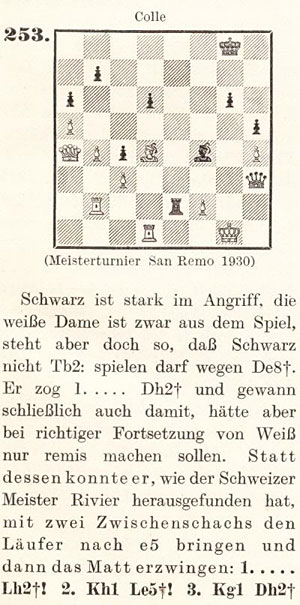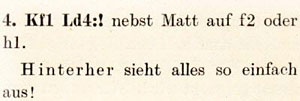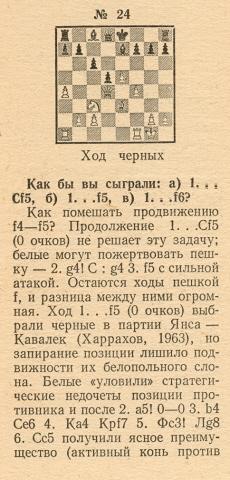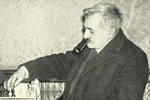Chess Explorations (95)
By Edward Winter
First of all, a case which may be considered little worse than soppy patriotism
combined (as patriotism so often is) with factual incompetence. In a feature
article on Chess (Basics, Laws and Terms) by B.K. Chaturvedi (Chandigarh,
2001) we commented:
In his 1995 match against Kasparov in New York, Anand won the first decisive
game (game 9) but scored only +0 –4 =4 in the remainder of the match.
Any respectable author would thus employ a word such as ‘comfortable’
or ‘decisive’ to describe Kasparov’s victory, but not Mr
Chaturvedi. He writes on page 3:
‘However, the most renowned Indian chess player to date is Vishwanath
[sic] Anand who recently challenged the current World Chess Champion
Gary Kasparov and missed the mark with a difference of just four [sic]
points.’
And from page 11 of this book (which, we reiterate, was published in 2001):
‘The present title holder is Gary Kasparov. He was challenged by
India’s Vishwanath [sic] Anand or “Vishy” in 1995
and despite Vishy’s claiming initial victories [sic –
the propagandist’s plural] and forcing Kasparov to draw, he eventually
lost. So Kasparov remains the undisputed Chess Champion.’
For all this, of course, Anand himself is blameless, just as it was hardly
Nigel Short’s fault that a small number of British ‘chess writers’
elected to slop jingoistic treacle over his shoulders before, during and after
his 1993 match with Kasparov.
At the other end of the scale there have been sombre periods when chess
literature has fallen victim to noxious racism. A quiz question: when Emanuel
Lasker died in 1941, how did Deutsche Schachblätter cover the event?
The answer is given at the end of this article.
The present section begins with a quote from page 10 of the January 1942
BCM (given in Chess:
Hitler and Nazi Germany):
‘The “New Order” in Germany is busy on chess literature.
The outstanding text-book in the German language is Dufresne’s Lehrbuch
des Schachspiels, which has held the field for some 60 years. From 1901
to 1937 it was periodically revised, and brought up to date by J. Mieses,
and so remained a thoroughly modern work.
As its popularity could not be gainsaid, it had to be “aryanized”,
and a new revision was entrusted to a 100 per cent Aryan master [Max Blümich
(1886-1942)].

Max Blümich
It will hardly be credited that the names of “non-Aryan” players
have been omitted from the historical section, including Kolisch, Zukertort,
Steinitz, Lasker, Rubinstein, etc. Not only that, all their most brilliant
games which adorned earlier editions have been eradicated, although a few
of their games were allowed to remain – those they lost! This is on
a par with the maintenance of “Aryan” superiority in chess by
the simple expedient of excluding non-Aryan competition.
There is only one word for it – lunacy. “Whom the gods wish to
destroy …”.’
Some recent C.N. items have discussed the conduct of Kurt Richter during the
Nazi regime. For example, C.N. 7875 referred to a position on page 113 of his
book Kombinationen (Berlin and Leipzig, 1936):


The game was Tartakower v Colle, San Remo, 2 February 1930, but throughout
the book the names of various (though not all) Jewish players were deleted.
For instance:
- Position 20: Post v unnamed opponent, Mannheim, 1914 (Flamberg);
- Position 167: S. v von Bardeleben, Hastings, 1895 (Steinitz);
- Position 197: von Holzhausen v unnamed opponent, 1912 (Tarrasch);
- Position 239: von Scheve v unnamed opponent, Ostend, 1907 (Rubinstein).
The process was intensified in the second edition of Richter’s book (Berlin,
1940), as shown by position 66 on page 29:

1936 edition

1940 edition
(The details about the Lasker v Thomas game are also wrong. See Chaos
in a Miniature.)
In the 1936 edition of Kombinationen ‘Dr Lasker’ was named
as the opponent of Bogoljubow (Zurich, 1934, in position 107) and of Torre (Moscow,
1925, in position 237). Four years later, the former world champion’s
name was reduced in both cases to ‘L.’.
Expurgations were even retained in the post-War translation Combinaciones
en el medio juego (Buenos Aires, 1947):

An example from page 158:

In the 1936 German edition Nimzowitsch had been identified in connection with
this position, but there was only ‘N.’ in the 1940 volume.
Later editions of Kombinationen restored the masters’ names. See
too C.N.s 7909 and 7923. In the latter item Alan McGowan (Waterloo, Canada)
gave a list of the Jewish players whose names were in the games index of the
Deutsche Schachblätter during the period 1934-39. (Richter took over
the editorship in January 1934.). The numbers dwindled and reached zero in 1939.
Now we turn to Eastern Europe and more recent times. C.N. 6832 reported:
ChessBase has reproduced from The Huffington Post an article entitled ‘A
Disappearing Act’ by Lubomir Kavalek. Two paragraphs:
‘In 1975 at the US Open, Navratilova asked for political asylum and
became persona non grata at home. Her name disappeared from the press. It
was a game the communist establishment liked to play. The censors axed your
name and the people learned how to read between the lines.
I met with similar fate after I left Czechoslovakia in 1968. Chess tournaments
in which I participated were not reported or appeared without my name. The
same year Martina left, a book of chess puzzles by two Czech grandmasters,
Vlastimil Hort and Vlastimil Jansa, was published in Prague. The publisher
Olympia printed 18,000 copies and when it was done, some censors discovered
my name attached to one of the games. They did something unbelievable: they
cut out the page with my name, printed a new one without my name and glued
it back in the book. They did it page by page, book by book – 18,000
times.’
No further details were given in Kavalek’s article, so in C.N. 6832 we
examined the Hort/Jansa book, Zahrajte si šachy s velmistry.

Of the 230 positions discussed, only one lacked the players’ names:


The nimble expurgation becomes clear only on close inspection: the sheet with
pages 31-32 is slightly shorter than the others.
Kavalek’s name was given in the English edition, The Best Move
(Great Neck, 1980), which was translated from the Czech by Irena Kavalek:

Page 16 of the Russian edition (Moscow, 1976) also included Kavalek’s
name:


However, in C.N. 7939 Vitaly A. Komissaruk (Kasan, Russian Federation) added
that there were deletions in the Russian edition:
‘The text for position 86 has a venue and a year, but White’s
name is omitted (Korchnoi). The venue, year and name of a player were removed
from positions 104 (Korchnoi), 135 (Korchnoi) and 203 (Sosonko).’
Our correspondent also mentioned that position 13 (shown below) did not identify
the players or give any venue or date:

The game was Hort v Shamkovich, Moscow, 1962, as stated on page 21 of the original
Czech edition of Hort and Jansa’s book.
The above, of course, are merely some examples which have been examined in
C.N. Other familiar political cases include the treatment of Ludĕk
Pachman.

Finally, the promised answer to the quiz question posed earlier in this article,
concerning the extent of the coverage in Deutsche Schachblätter of Emanuel
Lasker’s death in 1941: there was no obituary or report of any kind.
Submit information
or suggestions on chess explorations
All ChessBase articles
by Edward Winter

Edward Winter is the editor of Chess
Notes, which was founded in January 1982 as "a forum for aficionados
to discuss all matters relating to the Royal Pastime". Since then, over 7,940
items have been published, and the series has resulted in four books by Winter:
Chess
Explorations (1996), Kings,
Commoners and Knaves (1999), A
Chess Omnibus (2003) and Chess
Facts and Fables (2006). He is also the author of a monograph on Capablanca
(1989). In 2011 a paperback
edition was issued.
Chess Notes is well known for its historical research, and anyone browsing
in its archives
will find a wealth of unknown games, accounts of historical mysteries, quotes
and quips, and other material of every kind imaginable. Correspondents from
around the world contribute items, and they include not only "ordinary readers"
but also some eminent historians – and, indeed, some eminent masters. Chess
Notes is located at the Chess
History Center. Signed copies of Edward Winter's publications are
currently available.







































